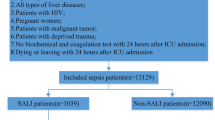Abstract
To examine the significance of physiologic and biochemical variables in liver trauma quantitatively, and to establish the early predictors of mortality according to the causes of death, 36 consecutive patients who underwent surgery for liver trauma between 1984 and 1993 were retrospectively studied. A univariate analysis revealed that shock, preoperative systolic blood pressure (SBP), preoperative alanine aminotransferase (ALT), the number of associated organ injuries, the Glasgow Coma Score (GCS), blood replacement requirements, and postoperative blood urea nitrogen (BUN) were significant prognostic factors of survival after liver trauma. However, a multivariate analysis indicated that GCS, postoperative BUN, the number of associated organ injuries, preoperative ALT, and SBP were independent prognostic factors. Because the causes of death after liver trauma can be divided into early hemorrhage and late sepsis, a multiple regression analysis of preoperative and postoperative variables was performed for each cause. The prognostic factors for hemorrhagic death were preoperative ALT, base excess, and the platelet count, whereas those for death due to sepsis were preoperative SBP and the presence of gastrointestinal injuries. These results suggest the value of measuring the preoperative serum level of ALT as a new independent prognostic factor for predicting overall and hemorrhagic death following severe liver trauma.
Similar content being viewed by others
References
Scott GM, Grasberger RC, Heeran TF, Williams LF, Hirsch EF (1988) Intraabdominal sepsis after hepatic trauma. Am J Surg 155:284–288
Durham RM, Buckley J, Keegan M, Fravell S, Shapiro MJ, Mazuski J (1992) Management of blunt hepatic injuries. Am J Surg 164:477–481
Pachter HL, Spencer FC, Hofstetter SR, Liang HG, Coppa GF (1992) Significant trends in the treatment of hepatic trauma. Experience with 411 injuries. Ann Surg 215:492–502
Anderson R, Bengmark S (1990) Conservative treatment of liver trauma. World J Surg 14:483–486
Hollands MJ, Little JM (1991) Non-operative management of blunt liver injuries. Br J Surg 78:968–72
Hammond JC, Canal DF, Broadie TA (1992) Nonoperative management of adult blunt hepatic trauma in a municipal trauma center. Am Surg 58:551–555
Watson CJ, Calne RY, Padani AR, Dixon AK (1991) Surgical restraint in the management of the trauma. Br J Surg 78:1071–1075
Reed R II, Merrell RC, Meyers WC, Fischer RP (1992) Continuing evolution in the approach to severe liver trauma. Ann Surg 216:524–538
Brotman S, Oliver G, Oster-Granite ML, Cowley RA (1984) The treatment of 179 blunt trauma-induced liver injuries in a statewide trauma center. Am Surg 50:603–608
Knaus WA, Draper EA, Wagner DP, Zimmerman JE (1985) APACHE II: A severity of disease classification system. J Trauma 13:818–829
Baker SP, O'Neill B, Haddon W, Long WB (1974) The injury severity score: A method for describing patients with multiple injuries and evaluating emergency care. J Trauma 14:187–196
Champion HR, Sacco WJ, Copes WS, Gann DS, Gennarelli TA, Flanagan ME (1989) A revision of the trauma score. J Trauma 29:623–629
Rutledge R, Fakhry S, Rutherford E, Muakkassa F, Meyer A (1993) Comparison of APACHE II, trauma score, and injury severity score as predictors of outcome in critically injured trauma patients. Am J Surg 166:244–247
Menegaux F, Langlois P, Chigot J-P (1993) Severe blunt trauma of the liver: study of mortality factors. J Trauma 35:865–869
Fabian TC, Croce MA, Stanford GG, Payne LW, Mangiante EC, Voeller GR, Kudsk KA (1991) Factors affecting morbidity following hepatic trauma. A prospective analysis of 482 injuries. Ann Surg 213:540–548
Yamamoto S, Kasai T, Maekawa K, Yoshii H (1989) The classification of liver trauma according to the Japanese Association for the Surgery of Trauma (in Japanese) J Jpn Assoc Surg Trauma 3:227–229
Siegel JH, Rivkind AR, Dalal SD, Goodarzi S (1990) Early physiologic predictors of injury severity and death in blunt multiple trauma. Arch Surg 125:498–508
Tran DD, Cuesta MA, van Leeuwen PAM, Nauta JJP, Wesdorp RIC (1993) Risk factors for multiple organ system failure and death in critically injured patients. Surgery 114:21–30
Sauaia A, Moore FA, Moore EE, Haenel JB, Read RA, Lezotte DC (1994) Early predictors of postinjury multiple organ failure. Arch Surg 129:39–45
Nichols RL, Smith JW, Robertson GD, Muzik AC, Pearce P, Azmen V, McSwain NE, Flint LM (1993) Prospective alteration in therapy for penetrating abdominal trauma. Arch Surg 128:55–64
Nishimura T, Yoshida Y, Watanabe F, Koseki M, Nishida T, Tagawa K, Kawashima Y (1986) Blood level of mitochondrial aspartate aminotransferase as an indicator of the extent of ischemic necrosis of the rat liver. Hepatology 6:701–707
Sahdev P, Garramone Jr R, Schwartz RJ, Steelman SR, Jacobs LM (1991) Evaluation of liver function tests in screening for intraabdominal injuries. Ann Emerg Med 20:838–841
Cogbill TH, Moore EE, Feliciano DV, Jurkovich GJ, Morris JA, Mucha Jr P (1992) Hepatic enzyme response and hyperpyrexia after severe liver injury. Am Surg 58:395–399
Housinger TA, Brinkerhoff C, Warden GD (1993) The relationship between platelet count, sepsis, and survival in pediatric burn patients. Arch Surg 128:65–67
Polk HC Jr. Factors influencing the risk of infection after trauma. Am J Surg 1993; 165:2S-7S
Guillou PJ (1993) Biological variation in the development of sepsis after surgery or trauma. Lancet 342:217–220
Rush Jr BF, Sori AJ, Murphy TF, Smith S, Flanagan JJ Jr, Machiedo GW (1988) Endotoxemia and bacteremia during hemorrhagic shock. The link between trauma and sepsis? Ann Surg 207:549–554
Author information
Authors and Affiliations
Rights and permissions
About this article
Cite this article
Nishida, T., Fujita, N. & Nakao, K. A multivariate analysis of the prognostic factors in severe liver trauma. Surg Today 26, 389–394 (1996). https://doi.org/10.1007/BF00311924
Received:
Accepted:
Issue Date:
DOI: https://doi.org/10.1007/BF00311924




